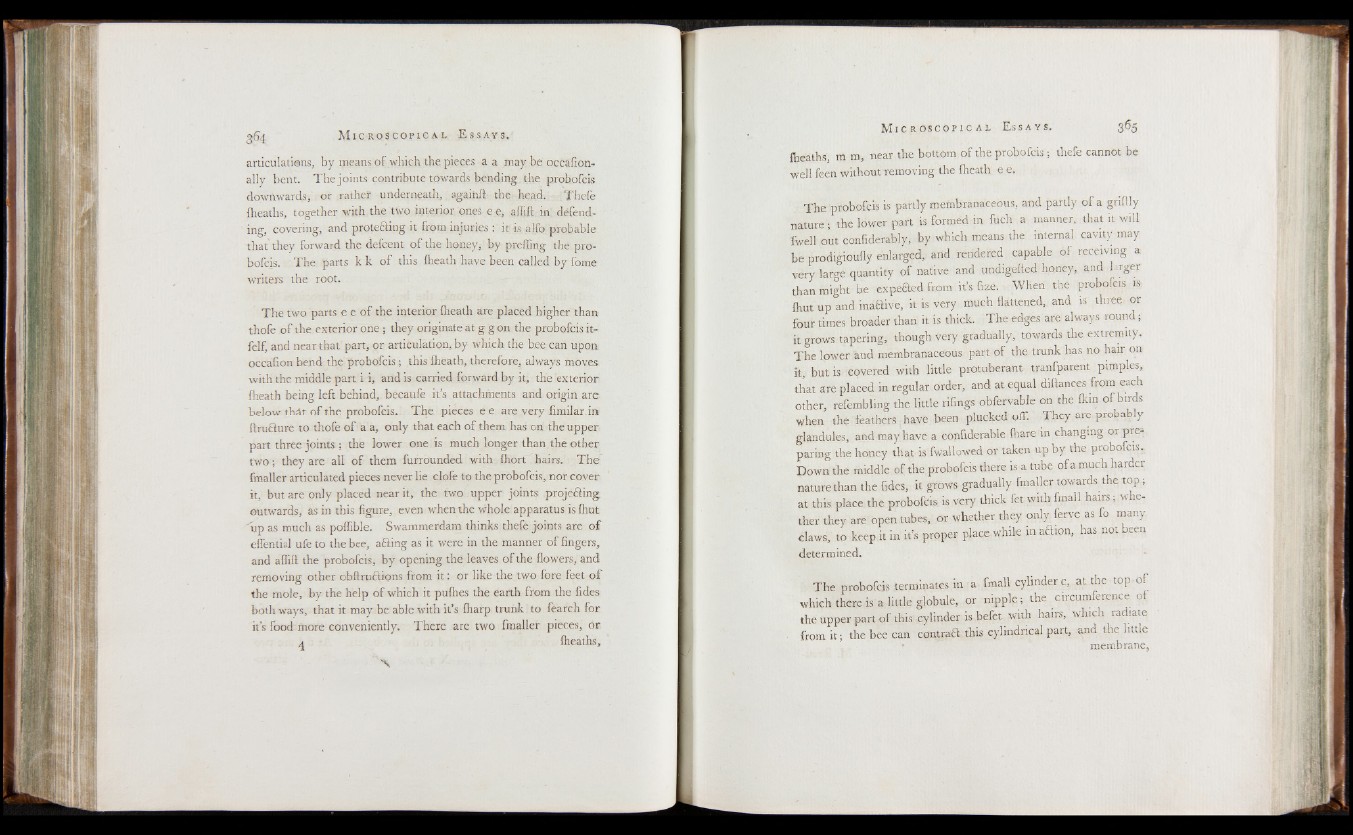
articulations, by means of which the pieces a a may be occafion-
ally bent. The joints contribute towards bending the probofcis
downwards, or rather underneath, againft the head. . Thefe
{heaths, together with the two interior ones e e, aflift in defending,
covering, and protecting it from injuries : it is alfo probable
that they forward the defcent of the honey, by prefling the probofcis.
The parts k k o f this {heath have been called by fome
writers the root.
The two parts e e of the interior {heath are placed higher than
thofe o f the exterior one ; they originate at g g on the probofcis it-
felf, and near that part, or articulation, by which the bee can upon
occafion bend the probofcis ; this Iheath, therefore, always moves
with the middle part i i, and is carried forward by it, the exterior
{heath being left behind, becaufe it’s attachments and origin are
below that of the probofcis. The pieces e e are very fimilar.in
ftru&ure to thofe o f a a, only that each o f them has on the upper
part three joints ; the lower one is much longer than the other
two ; they are all of them furrounded with {hort hairs. The"
fmaller articulated pieces never lie clofe to the probofcis, nor cover
it, but are only placed near it, the two upper joints projefting
outwards, as in this figure, even when the whole apparatus is flint
'up as much as poflible. Swammerdam thinks thefe joints are o f
eflendal ufe to the bee, aiding as it were in the manner o f fingers,
and aflift the probofcis, by opening the leaves of the flowers, and
removing other obftruftions from it: or like the two fore feet o f
the mole, by the help o f which it pufhes the earth from the fides
both ways, that it may be able with it’s {harp trunk to fearch for
it’s food more conveniently. There are two fmaller pieces, or
4 {heaths,
A
{heaths, m m, near the bottom of the probofcis; thefe cannot be
well feen without removing the {heath e e.
The probofcis is partly membranaceous, and partly of a griflly
nature; the lower part is formed in fuch a manner, that it will
fwell out confiderably, by which means the internal cavity may
be prodigioufly enlarged, and rendered capable o f receiving a
very large quantity of native and undigefted honey, and 1-irgef
than might be expeaed from it’s fize. When the probofcis is
{hut up and inaftive, it is very much flattened, and is three or
four times broader than it is thick. The edges are always round;
it grows tapering, though very gradually, towards the extremity.
The lower and membranaceous part of the trunk has no hair on
it, but is covered with little protuberant tranfparent pimples,
that are placed in regular order, and at equal diftances from each
other, refembling the little rifings obfervable on the flan o f birds
when the feathers have been plucked off. They are probably
glandules, and may have a confiderable {hare in changing or preparing
the honey that is fwallowed or taken up by the probofcis.
Down the middle of the probofcis there is a tube of a much harder
nature than the fides, it grows gradually fmaller towards the top ;
at this place the probofcis is very thick fet with-final 1 hairs ; whether
they are open tubes, or whether they only ferve as fo many
claws, to keep it in it’s proper place while m aaion, has not been
determined.
The probofcis terminates in a fmall cylinder c, at the top o f
which there is a little globule, or nipple ; the circumference of
the upper part o f this cylinder is befet with hairs, which ra late
from it; the bee can comma this cylindrical part, and the little
membrane,